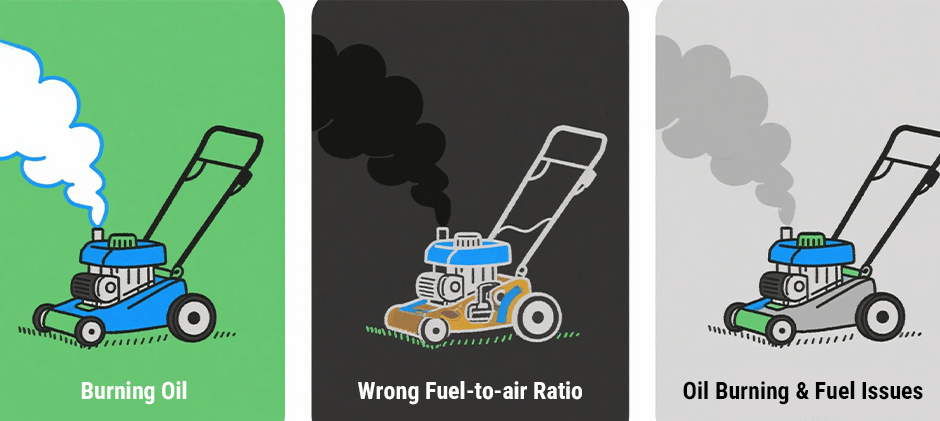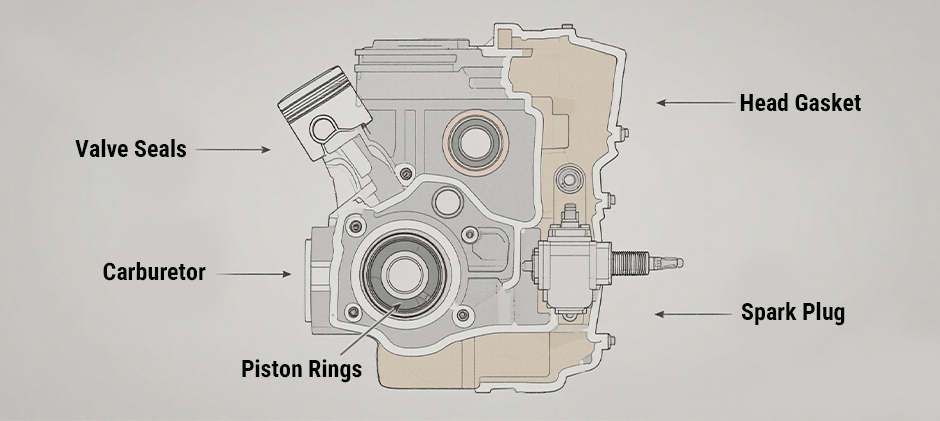Is your lawn mower experiencing smoking, and you don’t know what to do? Well, don’t freak out. Lawn mower smoking is actually a common issue that can strike into the hearts of homeowners, but most of the time, a smoking lawn mower points to a fixable problem. To solve the problem and save your machine, the first thing you need to do is figure out the cause. Typically, there are 3 types of mower smoking, and each of them stands for a different problem.
In this guide, I will walk you through the most frequent reasons your lawn mower might be smoking, explain what the smoke’s color tells you, and provide clear steps to get your mower back in top shape.
Also read: 7 Top Reasons Your Lawn Mower Won’t Start (And How to Fix Them)

What Color Means What?
Before you start troubleshooting, observing the color of the smoke is crucial. Different colors indicate different underlying issues, helping you narrow down the possibilities.
1. White or Bluish-White Smoke: Burning Oil
This is the most common type of smoke you’ll see. White or bluish-white smoke almost always signals that your engine is burning oil. This happens when oil gets into the combustion chamber and is ignited along with the fuel.
“White or bluish smoke coming from your engine usually indicates burning oil,” confirms Briggs & Stratton, a leading engine manufacturer.
Common causes for white or bluish-white smoke include:
- Overfilled Oil: One of the simplest and most frequent reasons. If you poured too much oil into the crankcase, the excess can overflow and burn in the cylinder. This is especially common if you’ve recently performed an oil change.
- Spilled or Leaking Oil: During maintenance, it’s easy to spill a little oil on hot engine components. This will burn off quickly and produce smoke. More seriously, actual oil leaks from gaskets or seals can drip onto hot parts, leading to persistent smoke. Check for oily residue around the engine block.
- Incorrect Oil Type: Using an oil that isn’t the right viscosity (thickness) for your mower’s engine or climate can cause it to burn improperly. Always consult your owner’s manual for the recommended oil.
- Worn Piston Rings or Valve Seals: These are internal engine components that help seal the combustion chamber. Over time, they can wear out, allowing oil to seep past them and into the area where fuel is burned. This is a more serious issue that often requires professional repair.
- Mower Tipped Improperly: If you’ve tilted your mower on its side to clean the deck or access the blades, and you didn’t tip it correctly (carburetor side up), oil can flow into the muffler or air filter, causing significant smoke when you restart it. This smoke should eventually burn off.
2. Black Smoke: Rich Fuel Mixture
Black smoke is less common but indicates a problem with the fuel-to-air ratio. It means your engine is getting too much fuel and not enough air, leading to incomplete combustion. Think of it like a car with a “rich” running engine.
The primary culprits for black smoke are:
- Clogged Air Filter: A dirty or clogged air filter restricts the amount of air entering the engine. With reduced airflow, the fuel mixture becomes too rich, causing black smoke. This is one of the most common and easiest fixes.
- Carburetor Issues: The carburetor is responsible for mixing air and fuel in the correct proportions. A faulty or improperly adjusted carburetor can send too much fuel to the engine. This might be due to a sticky float, a worn needle valve, or debris in the jets.
- Choke Engaged Too Long: If your mower has a manual choke and you leave it on for too long after the engine warms up, it will continue to provide a rich mixture, resulting in black smoke.
3. Grey Smoke: Engine Wear or Head Gasket Issues
Grey smoke can be a mix of white and black, sometimes indicating both oil burning and fuel issues. It can also be a sign of advanced engine wear.
- Worn Engine Components: As engines age, components like piston rings and cylinder walls can wear, leading to both oil burning and less efficient combustion. Grey smoke, especially in older mowers, can be a sign that the engine is nearing the end of its life.
- Blown Head Gasket: A head gasket seals the engine block and cylinder head, preventing oil, coolant, and combustion gases from mixing. If it blows, oil or even fuel can leak into the combustion chamber, leading to persistent grey smoke. This is a serious mechanical failure.

Step-by-Step Troubleshooting Your Smoking Lawn Mower
Now that you know what the smoke color suggests, let’s go through some practical steps to diagnose and resolve the issue.
1. Check the Oil Level and Condition (for White/Bluish Smoke)
- Is it Overfilled? Use the dipstick to check the oil level. If it’s above the “full” mark, you’ve likely overfilled it. You’ll need to drain the excess oil until it reaches the correct level.
- Spilled Oil? Visually inspect the engine for any oil spills, especially around the exhaust or muffler. If you find any, clean them off. The smoke should stop once the spilled oil burns off.
- Oil Type: Confirm you’re using the correct type of oil as recommended by your mower’s manufacturer.
- Recent Tipping? If you tipped the mower, let it run for a while. The smoke should clear as any oil that entered the muffler or air filter burns off. If it doesn’t, you might need to clean or replace the air filter.
2. Inspect and Clean/Replace the Air Filter (for Black Smoke)
- Location: The air filter is usually housed in a plastic or metal case on the side of the engine.
- Condition: Remove the cover and inspect the filter. If it’s dirty, clogged with grass clippings, or saturated with oil, it needs attention.
- Cleaning (foam filters): Some foam filters can be cleaned with soap and water, then allowed to dry completely and lightly oiled before reinstallation.
- Replacement (paper filters): Most paper filters are not meant to be cleaned and should be replaced if dirty.
- Test: After cleaning or replacing the filter, start the mower. The black smoke should disappear as the engine receives proper airflow.
3. Examine the Spark Plug
A fouled or failing spark plug can lead to incomplete combustion and smoke, regardless of color.
- Removal: Carefully remove the spark plug using a spark plug wrench.
- Inspection: Look for any signs of oil residue, carbon buildup, or damage to the electrode.
- Cleaning: If it’s just fouled, you can try cleaning it with a wire brush.
- Replacement: If it’s heavily fouled, damaged, or oily (especially with white smoke), it’s best to replace it. A new spark plug ensures efficient ignition.
4. Consider the Carburetor (for Persistent Black Smoke)
If cleaning the air filter doesn’t resolve black smoke, the carburetor might be the culprit.
- Adjustments: Some carburetors have adjustment screws for the fuel mixture, but these are best left to experienced individuals. Improper adjustments can cause more problems.
- Cleaning/Rebuild: A dirty carburetor can have clogged jets. It may need cleaning with a carburetor cleaner or a complete rebuild kit if internal components are worn. This can be complex for a novice.
5. Evaluate Engine Overheating
Overheating can cause oil to thin and burn, leading to smoke.
- Cooling Fins: Ensure the engine’s cooling fins are clear of debris (grass, dirt). Clogged fins prevent proper heat dissipation.
- Oil Level: Too little oil can also cause overheating due to increased friction.
6. Blown Head Gasket or Worn Internal Components (for Persistent White/Grey Smoke)
If you’ve checked all the easier fixes and your mower continues to produce significant white or grey smoke, especially with a noticeable loss of power, a blown head gasket or severely worn internal engine components (like piston rings) are likely.
- Symptoms: Besides smoke, you might notice a loss of engine compression, engine misfires, or oil/coolant mixing.
- Professional Help: These repairs are typically beyond the scope of basic DIY and usually require a small engine mechanic.
Summary of Smoke Colors and Common Causes
Here’s a quick reference table to help you diagnose the smoke from your lawn mower:
| Smoke Color | Common Causes | Severity | Common Fixes |
|---|---|---|---|
| White/Bluish | Overfilled oil, spilled oil, incorrect oil type | Low to Medium | Adjust oil level, clean spills, use correct oil, replace spark plug. |
| improper tipping, worn piston rings/valve seals | (Rings/seals often need professional repair) | ||
| Black | Clogged air filter, carburetor issues, choke on too long | Low to Medium | Clean/replace air filter, adjust/clean carburetor, release choke. |
| Grey | Blown head gasket, significant engine wear | High | Professional repair or engine replacement. |
Prevention is Key
Taking a few proactive steps can help prevent your lawn mower from smoking:
- Regular Oil Changes: Follow your manufacturer’s recommendations for oil change intervals.
- Check Oil Level Before Each Use: Always ensure the oil is at the correct level, but don’t overfill.
- Keep Air Filter Clean: Inspect and clean/replace the air filter regularly, especially in dusty conditions.
- Proper Tipping: If you need to tip your mower, always do so with the carburetor side facing upwards to prevent oil from flowing where it shouldn’t.
- Use the Right Fuel: Use fresh, clean gasoline, and avoid old or contaminated fuel.
Conclusion
While a smoking lawn mower can be alarming, identifying the color of the smoke and systematically checking the common culprits usually leads to a straightforward solution. For homeowners and new operators, focusing on oil levels, air filter condition, and spark plug health will resolve the majority of smoking issues. For more complex problems like worn internal components or a blown head gasket, seeking professional help is the wisest course of action. Keep your mower well-maintained, and it will serve you reliably for years to come.
If you come to FridayParts, you will not only find professional guidance but also high-quality aftermarket mower parts at affordable prices, with a vast inventory that provides wide compatibility for many mower brands, including lawn mowers. Don’t let a smoking mower ruin your weekend – explore our selection of air filters, spark plugs, and engine components today to find the exact parts you need to get back to a perfectly manicured lawn!
